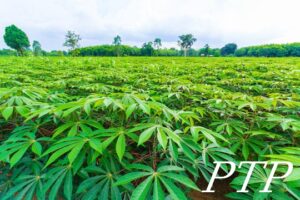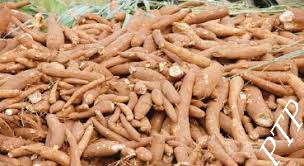Steps to cultivate cassava, some common varieties and why cultivate cassava.

Guides to cultivating cassava.

Growing cassava requires the right conditions and a series of steps to ensure successful cultivation. Here is some guides on how to grow cassava but these practices may vary depending on your location, local climate, and cassava variety.
Climate and soil requirements:
- Cassava grows best in tropical or subtropical regions with temperatures between 26-31°C. It can tolerate temperatures as high as 41°C but is sensitive to frost.
- The soil should be well-drained, loose, and sandy with a pH range of 5.6-6.9. Avoid heavy clay soils that retain too much water.
Selecting healthy cassava stems:
- Obtain healthy cassava stems from a reputable source or save stems from a previous harvest. Select stems that are disease-free and have at least three to four nodes.
Preparing the planting site:
- Clear the planting area of weeds, rocks, and debris. Cassava can grow in marginal soils but performs best in fertile soil.
- Plow or till the soil to a depth of about 30 cm to loosen it and create a fine seedbed.
Planting:
- Cut the selected cassava stems into 15-30 cm long pieces, ensuring each piece has at least three to four nodes.
- Plant the stem cuttings in rows or a grid pattern, spacing them about 1-1.5 meters (3-5 feet) apart.
- Dig holes approximately 3-5 inches deep and place the stem cuttings upright into the holes, burying them up to the second or third node slightly slanted.
Care and maintenance:
- Water the newly planted cassava cuttings immediately after planting. Subsequently, water the plants regularly, especially during dry periods.
- Weed the planting area regularly to prevent competition for nutrients and water.
- Fertilize the cassava plants with balanced fertilizers, rich in nitrogen, phosphorus, and potassium, according to the soil’s nutrient requirements.
- Mulch around the cassava plants to retain soil moisture and control weed growth if necessary.
- Monitor for pests and diseases. Common cassava pests include mealybugs, spider mites, and cassava green mites. Treat any infestations promptly using appropriate organic or chemical methods.
Harvesting:
- Cassava typically matures in 9-12 months, depending on the variety and growing conditions. Signs of maturity include yellowing and drying of the lower leaves.
- To harvest, carefully dig around the base of the plant and lift the tuberous roots out of the ground.
- Cut off the stems and branches, leaving a small portion attached to the tubers.
- Store the harvested cassava in a cool, dry place to prevent spoilage.
Some common varieties of cassava
There are many varieties of cassava cultivated around the world, each with its unique characteristics and suitability for different purposes. Here are some common cassava varieties:
Dual-Purpose Cassava:
- Dual-purpose cassava varieties are grown for both their edible roots and foliage, which can be used as animal feed.
- These varieties offer a balance between root yield and leaf biomass.
- Examples of dual-purpose cassava varieties include ‘IITA TMS 30572,’ ‘IITA TMS 419,’ and ‘IITA TMS 98/0505.’
Manihot esculenta Crantz(Bitter Cassava):
- Bitter cassava varieties contain higher levels of cyanide in their roots and are not suitable for direct consumption.
- They are mainly used for processing into flour, starch, or other industrial products.
- Bitter cassava requires proper processing methods, such as peeling, soaking, fermenting, and cooking, to remove the cyanide and make them safe for consumption.
- Examples of bitter cassava varieties include ‘IITA TMS 30555,’ ‘M Col 22,’ and ‘TMS 4(2)1425.’
High-Starch Cassava:
- High-starch cassava varieties are preferred for industrial purposes, particularly for producing cassava flour, starch, or ethanol.
- These varieties have a higher starch content and are often selected for their productivity and processing qualities.
- Examples of high-starch cassava varieties include ‘IITA TMS 98/0510,’ ‘IITA TMS 96/1414,’ and ‘M Col 1148.’
Manihot esculenta Crantz(Sweet Cassava):
- This variety is primarily grown for its sweet-tasting roots, which are consumed as a starchy vegetable.
- Sweet cassava varieties have lower levels of cyanide compared to bitter varieties, making them safer for direct consumption.
- Examples of sweet cassava varieties include ‘Kigoma,’ ‘IITA TMS 30572,’ and ‘IITA TME 419.’


Why the need to cultivate cassava
Growing cassava becomes necessary to ensure food security, promote sustainable agriculture, support rural livelihoods, and contribute to economic development in many regions around the world.
Rural Development:
- Cassava cultivation can contribute to rural development by creating employment opportunities, supporting local economies, and reducing rural-urban migration.
- It empowers farmers and communities, particularly in regions with limited agricultural alternatives, by providing a viable crop option for income generation and economic stability.
Income Generation:
- Cassava cultivation provides income opportunities for farmers, particularly in rural areas.
- The crop can be sold in local markets as fresh produce, and the roots can be processed into value-added products such as cassava flour, starch, chips, snacks, or ethanol.
- This contributes to the livelihoods of small-scale farmers and promotes rural economic development.
Food Security:
- Cassava is a crucial source of food for millions of people, particularly in developing countries.
- It provides a reliable and affordable source of carbohydrates, which is an essential component of a balanced diet.
- In regions where other staple crops may fail due to drought, poor soil conditions, or pests, cassava can serve as a resilient and dependable food source, contributing to food security.
Versatility and Utilization:
- Cassava is a versatile crop that can be used in various ways.
- Apart from its use as a staple food, it can be processed into a range of products, including flour, starch, animal feed, biofuels, and industrial materials.
- Its diverse utilization potential enhances its economic value and promotes agro-industrial development.
Climate Resilience:
- Cassava is known for its ability to thrive in challenging growing conditions.
- It can tolerate drought, high temperatures, and poor soil quality better than many other crops.
- In regions with unpredictable rainfall patterns or where water availability is limited, cassava can be a suitable crop that helps farmers adapt to climate change and maintain agricultural productivity.
Soil Conservation:
- Cassava has a deep root system that helps improve soil structure and reduce erosion.
- Its extensive root system helps prevent soil degradation and improves soil fertility, making it a valuable crop for sustainable agricultural practices.





